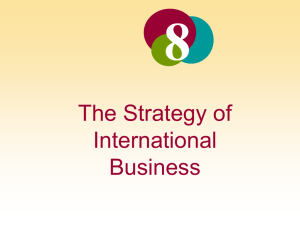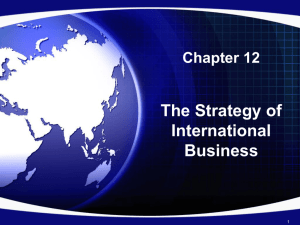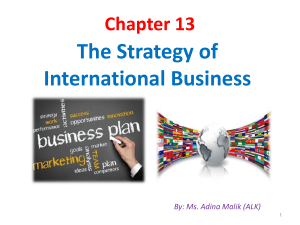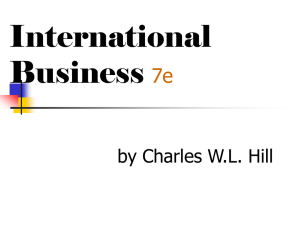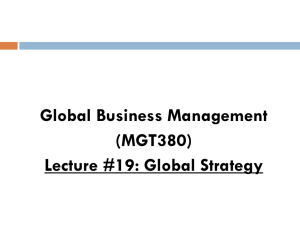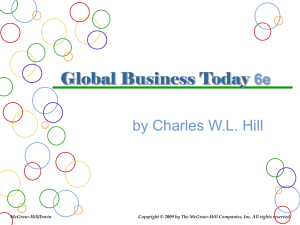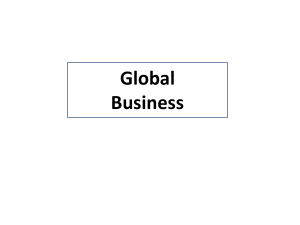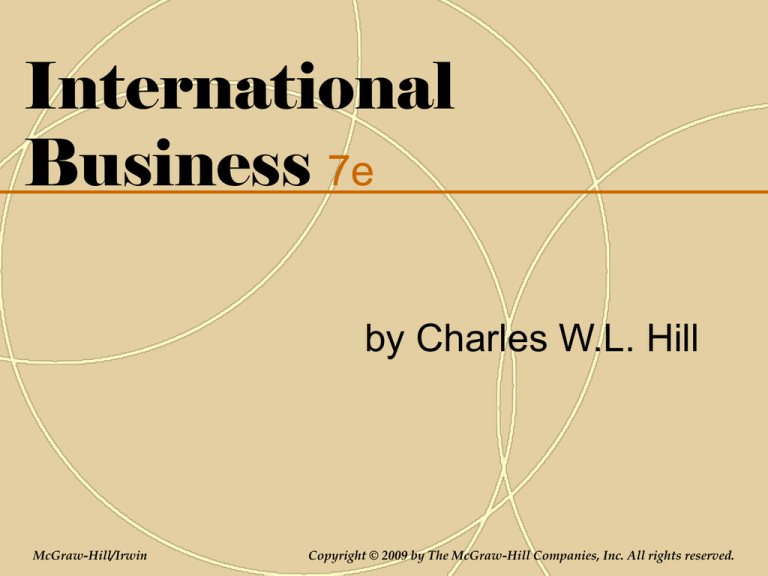
International
Business 7e
by Charles W.L. Hill
McGraw-Hill/Irwin
Copyright © 2009 by The McGraw-Hill Companies, Inc. All rights reserved.
Chapter 12
The Strategy of International
Business
Introduction
What actions can managers take to compete more
effectively as an international business?
How can firms increase profits through international
expansion?
What international strategy should firms pursue?
12-3
Strategy And The Firm
A firm’s strategy refers to the actions that managers take
to attain the goals of the firm
Profitability can be defined as the rate of return the firm
makes on its invested capital
Profit growth is the percentage increase in net profits
over time
Expanding internationally can boost profitability and profit
growth
12-4
Strategy And The Firm
Figure 12.1: Determinants of Enterprise Value
12-5
Value Creation
The value created by a firm is measured by the difference
between V (the price that the firm can charge for that
product given competitive pressures) and C (the costs of
producing that product)
The higher the value customers place on a firm’s
products, the higher the price the firm can charge for those
products, and the greater the profitability of the firm
12-6
Value Creation
Figure 12.2: Value Creation
12-7
Classroom Performance System
What is the rate of return the firm makes on its invested
capital?
a) Profit growth
b) Profitability
c) Net return
d) Value created
12-8
Value Creation
Profits can be increased by:
adding value to a product so that customers are willing to
pay more for it – a differentiation strategy
lowering costs – a low cost strategy
Michael Porter argues that superior profitability goes to
firms that create superior value by lowering the cost
structure of the business and/or differentiating the product
so that a premium price can be charged
12-9
Strategic Positioning
Michael Porter argues that firms need to choose either
differentiation or low cost, and then configure internal
operations to support the choice
To maximize long run return on invested capital, firms must:
pick a viable position on the efficiency frontier
configure internal operations to support that position
have the right organization structure in place to execute
the strategy
12-10
Strategic Positioning
Figure 12.3: Strategic Choice in the International Hotel
Industry
12-11
Operations: The Firm As A Value Chain
A firm’s operations can be thought of a value chain
composed of a series of distinct value creation activities,
including production, marketing, materials management,
R&D, human resources, information systems, and the firm
infrastructure
Value creation activities can be categorized as primary
activities (R&D, production, marketing and sales, customer
service) and support activities (information systems,
logistics, human resources)
12-12
Classroom Performance System
Which of the following is not an example of a primary
activity?
a) Logistics
b) Marketing and sales
c) Customer service
d) Production
12-13
Operations: The Firm As A Value Chain
Figure 12.4: The Value Chain
12-14
Global Expansion, Profitability,
And Profit Growth
International firms can:
expand the market for their domestic product offerings by
selling those products in international markets
realize location economies by dispersing individual value
creation activities to locations around the globe where they
can be performed most efficiently and effectively
realize greater cost economies from experience effects
by serving an expanded global market from a central
location, thereby reducing the costs of value creation
earn a greater return by leveraging any valuable skills
developed in foreign operations and transferring them to
other entities within the firm’s global network of operations
12-15
Expanding The Market: Leveraging
Products And Competencies
Firms can increase growth by selling goods or services
developed at home internationally
The success of firms that expand internationally depends
on the goods or services they sell, and on their core
competencies (skills within the firm that competitors cannot
easily match or imitate)
Core competencies enable the firm to reduce the costs of
value creation and/or to create perceived value in such a
way that premium pricing is possible
12-16
Location Economies
When firms base each value creation activity at that
location where economic, political, and cultural conditions,
including relative factor costs, are most conducive to the
performance of that activity, they realize location
economies (the economies that arise from performing a
value creation activity in the optimal location for that
activity, wherever in the world that might be)
By achieving location economies, firms can:
lower the costs of value creation and achieve a low cost
position
differentiate their product offering
12-17
Location Economies
Firms that take advantage of location economies in
different parts of the world, create a global web of value
creation activities
Under this strategy, different stages of the value chain
are dispersed to those locations around the globe where
perceived value is maximized or where the costs of value
creation are minimized
A caveat:
transportation costs, trade barriers, and political risks
complicate this picture
12-18
Classroom Performance System
What is created when different stages of a value chain are
dispersed to locations where value added is maximized or
where the costs of value creation are minimized?
a) Experience effects
b) Learning effects
c) Economies of scale
d) A global web
12-19
Experience Effects
The experience curve refers to the systematic reductions
in production costs that have been observed to occur over
the life of a product
Learning effects are cost savings that come from learning
by doing
So, when labor productivity increases, individuals learn
the most efficient ways to perform particular tasks, and
management learns how to manage the new operation
more efficiently
12-20
Experience Effects
Figure 12.5: The Experience Curve
12-21
Experience Effects
Economies of scale refer to the reductions in unit cost achieved by
producing a large volume of a product
Sources of economies of scale include:
spreading fixed costs over a large volume
utilizing production facilities more intensively
increasing bargaining power with suppliers
By moving down the experience curve, firms reduce the cost of
creating value
To get down the experience curve quickly, firms can use a single
plant to serve global markets
12-22
Leveraging Subsidiary Skills
It is important for managers to:
recognize that valuable skills that could be applied
elsewhere in the firm can arise anywhere within the firm’s
global network (not just at the corporate center)
establish an incentive system that encourages local
employees to acquire new skills
have a process for identifying when valuable new skills
have been created in a subsidiary
12-23
Summary
Managers need to keep in mind the complex relationship
between profitability and profit growth when making
strategic decisions about pricing
In some cases, it may be worthwhile to price products
low relative to their perceived value in order to gain market
share
12-24
Cost Pressures And Pressures
For Local Responsiveness
Firms that compete in the global marketplace typically face
two types of competitive pressures:
pressures for cost reductions
pressures to be locally responsive
These pressures place conflicting demands on the firm
Pressures for cost reductions force the firm to lower unit
costs, but pressure for local responsiveness require the
firm to adapt its product to meet local demands in each
market—a strategy that raises costs
12-25
Cost Pressures And Pressures
For Local Responsiveness
Figure 12.6: Pressures for Cost Reductions and Local
Responsiveness
12-26
Pressures For Cost Reductions
Pressures for cost reductions are greatest:
in industries producing commodity type products that fill
universal needs (needs that exist when the tastes and
preferences of consumers in different nations are similar if
not identical) where price is the main competitive weapon
when major competitors are based in low cost locations
where there is persistent excess capacity
where consumers are powerful and face low switching
costs
12-27
Pressures For Local Responsiveness
Pressures for local responsiveness arise from:
differences in consumer tastes and preferences - strong
pressures for local responsiveness emerge when
consumer tastes and preferences differ significantly
between countries
differences in traditional practices and infrastructure pressures for local responsiveness emerge when there are
differences in infrastructure and/or traditional practices
between countries
12-28
Pressures For Local Responsiveness
differences in distribution channels - a firm's marketing
strategies needs to be responsive to differences in
distribution channels between countries
host government demands - economic and political
demands imposed by host country governments may
necessitate a degree of local responsiveness
12-29
Classroom Performance System
Which of the following is not a pressure for local
responsiveness?
a) Excess capacity
b) Host government demands
c) Differences in consumer tastes and preferences
d) Differences in distribution channels
12-30
Choosing A Strategy
There are four basic strategies to compete in the
international environment:
global standardization
localization
transnational
International
The appropriateness of each strategy depends on the
pressures for cost reduction and local responsivness in the
industry
12-31
Choosing A Strategy
Figure 12.7: Four Basic Strategies
12-32
Global Standardization Strategy
The global standardization strategy focuses on
increasing profitability and profit growth by reaping the cost
reductions that come from economies of scale, learning
effects, and location economies
The strategic goal is to pursue a low-cost strategy on a
global scale
The global standardization strategy makes sense when:
there are strong pressures for cost reductions
demands for local responsiveness are minimal
12-33
Localization Strategy
The localization strategy focuses on increasing
profitability by customizing the firm’s goods or services so
that they provide a good match to tastes and preferences in
different national markets
The localization strategy makes sense when:
there are substantial differences across nations with
regard to consumer tastes and preferences
where cost pressures are not too intense
12-34
Transnational Strategy
The transnational strategy tries to simultaneously:
achieve low costs through location economies,
economies of scale, and learning effects
differentiate the product offering across geographic
markets to account for local differences
foster a multidirectional flow of skills between different
subsidiaries in the firm’s global network of operations
The transnational strategy makes sense when:
cost pressures are intense
pressures for local responsiveness are intense
12-35
International Strategy
The international strategy involves taking products first
produced for the domestic market and then selling them
internationally with only minimal local customization
The international strategy makes sense when
there are low cost pressures
low pressures for local responsiveness
12-36
Classroom Performance System
Which strategy tries to simultaneously achieve low costs
through location economies, economies of scale, and
learning effects, and differentiate the product offering
across geographic markets to account for local
differences?
a) Internationalization
b) Localization
c) Global standardization
d) Transnational
12-37
The Evolution of Strategy
An international strategy may not be viable in the long
term
To survive, firms may need to shift to a global
standardization strategy or a transnational strategy in
advance of competitors
Similarly, localization may give a firm a competitive edge,
but if the firm is simultaneously facing aggressive
competitors, the company will also have to reduce its cost
structures, and the only way to do that may be to shift
toward a transnational strategy
12-38
The Evolution of Strategy
Figure 12.8: Changes in Strategy over Time
12-39
Classroom Performance System
Which strategy makes sense when pressures are high for
local responsiveness, but low for cost reductions?
a) Global standardization strategy
b) International strategy
c) Transnational strategy
d) Localization strategy
12-40

